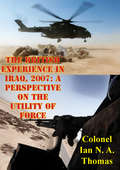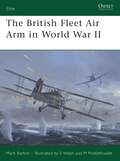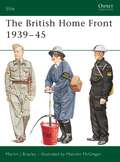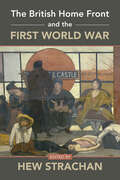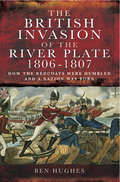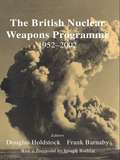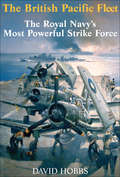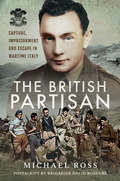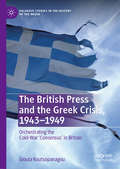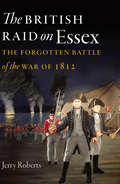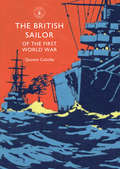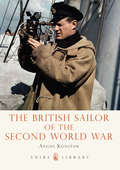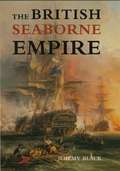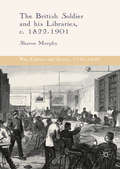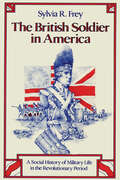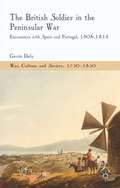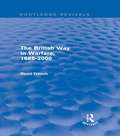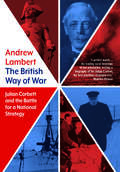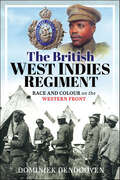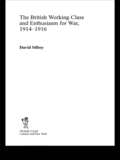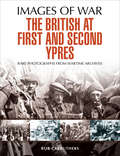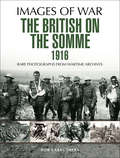- Table View
- List View
The British Experience In Iraq From 1914-1926: What Wisdom Can The United States Draw From Its Experience?
by Major Matthew W. WilliamsThis thesis examines the British experience in Iraq from 1914-1926. Britain invaded Iraq to secure its oil interests and to protect its lines of communication to India. The British initially defeated Ottoman forces and captured the Basra vilayet (province) in December 1914. Although Basra's capture accomplished the objectives that Britain had sought to achieve at the outset of the campaign, it was followed by an ill-advised advance to Baghdad that culminated in defeat by the Ottomans at Kut-al-Amara in 1916. The British regrouped, however, and resumed the offensive, capturing Baghdad in 1917 and Mosul in 1918. After the war, Britain managed Iraq as a League of Nations Mandate from 1920-1932. The British installed Iraq's first ruler, King Feisal I in 1921 and helped demarcate its northern border with Turkey in 1926.This thesis explores the British military campaign in Iraq during World War I and its subsequent civil administration. The thesis will examine the actions Britain took during this time period and determine, what wisdom, if any, that the United States (US) can draw from these experiences in relation to its current efforts in Iraq. This study concludes that, if the US is going to accomplish its objectives in Iraq, it should base its future relationship with Iraq primarily by incentives and not coercion. Furthermore, any attempt by the US to simultaneously develop Iraq into an independent nation-state and maintain dominant, long-term influence will likely result in failure. Overall, if the US wants to accomplish its goals in Iraq, it should treat Iraq like an equal and strive to be the best friend it has never had.
The British Experience In Iraq, 2007: A Perspective On The Utility Of Force
by Colonel Ian N. A. ThomasRecent years have seen the US, UK and other ISAF and Coalition nations enmeshed in protracted, complex and intense campaigns in Iraq and Afghanistan. Resilient and highly adaptable opponents have operated asymmetrically, and amongst the people, to negate the technological superiority of the West; counterinsurgency (COIN) has been the norm. Progress made has been hard won, consuming considerable resources and testing national will. Despite the achievement of often rapid and spectacular tactical military successes, the desired political dividends have been slower to materialise and scarcely commensurate with the investment of national blood and treasure. This has led some to question the utility of military force and the mood in several Western capitals seems increasingly wary of further stabilisation campaigns abroad. This sense of caution is reinforced by the global economic downturn and its associated fiscal challenges, which have encouraged retrenchment in public spending, especially in defence budgets. It would seem timely, given this context, to reflect upon the utility of force.This monograph examines the purpose and dominant characteristics of military force and highlights the conditions that must obtain if military success is to be translated into political advantage in the contemporary operating environment. It uses recent British experience in Iraq to illustrate some of the challenges involved. It concludes that despite the complexity and frustrations of Iraq and Afghanistan, armed force retains utility in the contemporary operational environment, as long as certain conditions are met. These are that the missions allocated to the military are appropriate, recognising the limitations of force; are adequately resourced; are properly integrated with other instruments of national power; and are underwritten with the requisite political commitment to sustain them over time.
The British Fleet Air Arm in World War II
by Stephen Walsh Mark BarberThis is a concise history of the Royal Navy's air arm during World War II (1939-1945), from the Arctic convoys, to the battle for Malta, to the last raids on Japan. The contribution of British Naval aviation to the ultimate Allied victory cannot be underestimated. Amazingly the Admiralty only had 406 operational pilots and 8 carriers when war broke out, but a mere 6 years later there were over 3,000 operational pilots and 53 aircraft carriers patrolling the seas in every theater of the war. The author charts the rapid evolution of the Fleet Air Arm during the war years as air power took over the cutting edge of naval warfare from surface battleships. The carriers were in action from the first with actions by HMS Ark Royal and Courageous in September 1939 to the major actions of the carrier force off Japan in the closing days of the war. This book offers a complete overview from recruitment and training to the thrilling accounts of operational successes and failures. Discover some of the most dramatic actions of the war as Royal Navy aces battled against Axis forces scoring both the first and last kills of the war.
The British Home Front 1939-45
by Martin Brayley Malcolm McgregorOsprey's study of the British home front during World War II (1939-1945). The population of Britain was mobilized to support the war effort on a scale unseen in any other Western democracy - or in Nazi Germany. They endured long working shifts, shortages of food and all other goods, and complete government control of their daily lives. Most men and women were conscripted or volunteered for additional tasks outside their formal working hours. Under the air raids that destroyed the centres of many towns and made about 2 million homeless, more than 60,000 civilians were killed and 86,000 seriously injured. This fascinating illustrated summary of wartime life, and the organizations that served on the Home front, is a striking record of endurance and sacrifice.
The British Home Front and the First World War
by Hew StrachanThe First World War required the mobilisation of entire societies, regardless of age or gender. The phrase 'home front' was itself a product of the war with parts of Britain literally a war front, coming under enemy attack from the sea and increasingly the air. However, the home front also conveyed the war's impact on almost every aspect of British life, economic, social and domestic. In the fullest account to-date, leading historians show how the war blurred the division between what was military and not, and how it made many conscious of their national identities for the first time. They reveal how its impact changed Britain for ever, transforming the monarchy, promoting systematic cabinet government, and prompting state intervention in a country which prided itself on its liberalism and its support for free trade. In many respects we still live with the consequences.
The British Invasion of the River Plate, 1806–1807: How the Redcoats were Humbled and a Nation was Born
by Ben HughesIn 1806 a British expeditionary force captured Buenos Aires. Over the next eighteen months, Britain was sucked into a costly campaign on the far side of the world. The Spaniards were humbled on the battlefield and Montevideo was taken by storm, but the campaign ended in disaster when 6000 redcoats and riflemen surrendered following a bloody battle in the streets of the Argentine capital. So ended one of the most humiliating and neglected episodes of the entire Napoleonic Wars.In The British Invasion of the River Plate Ben Hughes tells the story of this forgotten campaign in graphic detail. His account is based on research carried out across two continents. It draws on contemporary newspaper reports, official documents and the memoirs, letters and journals of the men who were there.He describes the initially successful British invasion, which was stopped when their troops were surrounded in Buenos Aires main square and forced to surrender, and the second British attack which was eventually defeated too. His narrative covers the course of the entire campaign and its aftermath. While focusing on the military and political aspects of the campaign, his book gives an insight into the actions of the main protagonists William Carr Beresford, Sir Home Popham, Santiago de Liniers and Black Bob Craufurd and into the experiences of the forgotten rank and file.He also considers the long-term impact of the campaign on the fortunes of the opposing sides. Many of the British survivors went on to win glory in the Peninsular War. For the Uruguayans and Argentines, their victory gave them a sense of national pride that would eventually encourage them to wrest their independence from Spain.
The British Nuclear Weapons Programme, 1952-2002
by Frank Barnaby Douglas HoldstockThe first British nuclear weapon test took place in Australia in October 1952. British nuclear weapons have been a source of controversy ever since. In this book, scientists, doctors, researchers and others assess the military value, political impact, health effects and legality of the programme.
The British Pacific Fleet: The Royal Navy's Most Powerful Strike Force
by David Hobbs&“Magnificent and important . . . should be on the shelves of anyone with a genuine interest in the history of the Royal Navy in the Second World War.&” —Military History Monthly In August 1944 the British Pacific Fleet did not exist. Six months later it was strong enough to launch air attacks on Japanese territory, and by the end of the war it constituted the most powerful force in the history of the Royal Navy, fighting as professional equals alongside the US Navy in the thick of the action. How this was achieved by a nation nearing exhaustion after five years of conflict is a story of epic proportions in which ingenuity, diplomacy and dogged persistence all played a part. As much a political as a technical triumph, the BPF was uniquely complex in its make-up: its C-in-C was responsible to the Admiralty for the general direction of his Fleet; took operational orders from the American Admiral Nimitz; answered to the Government of Australia for the construction and maintenance of a vast base infrastructure, and to other Commonwealth Governments for the ships and men that formed his fully-integrated multi-national fleet. This ground-breaking new work by David Hobbs describes the background, creation and expansion of the BPF from its first tentative strikes, through operations off the coast of Japan to its impact on the immediate post-war period, including the opinions of USN liaison officers attached to the British flagships. The book is the first to demonstrate the real scope and scale of the BPF&’s impressive achievement.&“Perhaps the greatest Royal Navy story of, at least, the twentieth century.&” —Aircrew Book Review
The British Partisan: Capture, Imprisonment and Escape in Wartime Italy
by Michael RossAn exciting, evocative memoir of combat in North Africa, danger behind enemy lines, and two daring escapes. In this action-packed account, a Welch Regiment officer describes his remarkable Second World War experiences. These include his baptism by fire in the Western Desert against Rommel&’s armor in 1942; the spontaneous help of nomad Arabs when he was on the run for ten days behind enemy lines; and his capture and life as a POW in Italy. Michael Ross and a fellow officer made the first escape from Fontanellato POW camp only to be recaptured on the Swiss border. During his second escape, Ross fought against the occupying German forces in north Italy alongside the Italian partisans, who nearly executed him initially. He avoided recapture for over a year before finally reaching Allied lines. The reader learns of the extraordinary courage and sacrifice of local Italians helping and hiding Allied soldiers. Ross&’s story has a poignant conclusion as, while on the run, he fell in love with a prominent anti-fascist&’s daughter whom he married after the war. Originally published as From Liguria With Love, this superbly written and updated memoir is a powerful and inspiring tribute to all those who risked their lives to help him and his comrades.
The British Press and the Greek Crisis, 1943–1949: Orchestrating the Cold-War ‘Consensus’ in Britain (Palgrave Studies in the History of the Media)
by Gioula KoutsopanagouThis book provides the first detailed analysis of how interactions between government policy and Fleet Street affected the political coverage of the Greek civil war, one of the first major confrontations of the Cold War. During this period the exponential growth of media influence was an immensely potent weapon of psychological warfare. Throughout the 1940s the press maintained its position as the most powerful medium and its influence remained unchallenged. The documentary record shows that a British media consensus was more fabricated than spontaneous, and the tools of media persuasion and manipulation were extremely important in building acceptance for British foreign policy. Gioula Koutsopanagou examines how this media consensus was influenced and molded by the British government and how Foreign Office channels were key to molding public attitudes to British foreign policy. These channels included system of briefings given by the News Department to the diplomatic correspondents, and the contacts between embassies and the British foreign correspondents.
The British Raid on Essex: The Forgotten Battle of the War of 1812 (The Driftless Connecticut Series)
by Jerry RobertsThis is the dynamic account of one of the most destructive maritime actions to take place in Connecticut history: the 1814 British attack on the privateers of Pettipaug, known today as the British Raid on Essex. During the height of the War of 1812, 136 Royal marines and sailors made their way up the Connecticut River from warships anchored in Long Island Sound. Guided by a well-paid American traitor the British navigated the Saybrook shoals and advanced up the river under cover of darkness. By the time it was over, the British had burned twenty-seven American vessels, including six newly built privateers. It was the largest single maritime loss of the war. Yet this story has been virtually left out of the history books--the forgotten battle of the forgotten war. This new account from author and historian Jerry Roberts is the definitive overview of this event and includes a wealth of new information drawn from recent research and archaeological finds. Lavish illustrations and detailed maps bring the battle to life.
The British Sailor of the First World War
by Quintin ColvilleIn 1914 Great Britain had the largest and most powerful navy the world had ever seen - a well-known fact, but what of the everyday experience of those who served in her? This fully illustrated book looks at the British sailor's life during the First World War, from the Falkland Islands to the East African coast to the North Sea. Meals in the stokers' mess and the admiral's cabin; the claustrophobic terrors of the engine room or submarine; the long separations from loved ones that were the shared experience of all ranks; the perils faced by Royal Naval Air Service pilots in the air; the possessions treasured by sailors while at sea - drawing on a wealth of previously unpublished materials from the National Maritime Museum archives, this is an authoritative and vivid account of lives lived in quite extraordinary circumstances.
The British Sailor of the Second World War
by Angus KonstamThis title tells the dramatic story of how the Royal Navy transformed ordinary citizens into first-rate and fearless sailors and navy personnel during World War II. It covers how they were recruited and trained, and how they endured life at sea in hostile waters, protecting convoys in the Atlantic, hunting submarines in the Mediterranean, and standing up to relentless air attacks in the Pacific. Told from the perspective of vivid first-hand accounts of life onboard, it reveals what it was like to be a sailor navigating, patrolling, and fighting in the largest theater of the war- the vast oceans.
The British Seaborne Empire
by Jeremy BlackThis book covers the period from around 1650-2004. From the preface: "within a general treatment of British imperial history, I emphasise one particular strand, its seaborne aspect, in order to throw light on the British, the people with whom they came into contact, the process of imperial expansion and the way in which empire was understood."
The British Soldier and his Libraries, c. 1822-1901
by Sharon MurphyThe British Soldier and his Libraries, c. 1822-1901 considers the history of the libraries that the East India Company and Regular Army respectively established for soldiers during the nineteenth century. Drawing upon a wide range of material, including archival sources, official reports, and soldiers' memoirs and letters, this book explores the motivations of those who were responsible for the setting up and/or operation of the libraries, and examines what they reveal about attitudes to military readers in particular and, more broadly, to working-class readers - and leisure - at this period. Murphy's study also considers the contents of the libraries, identifying what kinds of works were provided for soldiers and where and how they read them. In so doing, The British Soldier and his Libraries, c. 1822-1901 affords another way of thinking about some of the key debates that mark book history today, and illuminates areas of interest to the general reader as well as to literary critics and military and cultural historians.
The British Soldier in America: A Social History of Military Life in the Revolutionary Period
by Sylvia R. FreyIn her investigation of the social history of the common British soldier in the era of the American Revolution, Sylvia Frey has extensively surveyed recruiting records, contemporary training manuals, statutes, and memoirs in an attempt to provide insight into the soldier's "life and mind." In the process she has discovered more about the common soldier than anyone thought possible: his social origins and occupational background, his size, age, and general physical condition, his personal economics and daily existence. Her findings dispel the traditional assumption that the army was made up largely of criminals and social misfits. Special attention is given to soldiering as an occupation. Focusing on two of the major campaigns of the war—the Northern Campaign which culminated at Saratoga and the Southern Campaign which ended at Yorktown—Frey describes the human face of war, with particular emphasis on the physical and psychic strains of campaigning in the eighteenth century. Perhaps the most important part of the work is the analysis of the moral and material factors which induced men to accept the high risks of soldiering. Frey rejects the traditional assumption that soldiers were motivated to fight exclusively by fear and force and argues instead that the primary motivation to battle was generated by regimental esprit, which in the eighteenth century substituted for patriotism. After analyzing the sources of esprit, she concludes that it was the sustaining force for morale in a long and discouraging war. This book is a contribution to our understanding of the eighteenth century and should appeal not only to military historians but also to social and economic historians and to those interested in the history of medicine.
The British Soldier in the Peninsular War
by Gavin DalyCombining military and cultural history, the book explores British soldiers' travels and cross-cultural encounters in Spain and Portugal, 1808-1814. It is the story of how soldiers interacted with the local environment and culture, of their attitudes and behaviour towards the inhabitants, and how they wrote about all this in letters and memoirs.
The British Way in Warfare 1688 - 2000 (Routledge Revivals)
by David FrenchFirst published in 1990, this title examines British defence policy from 1688 onwards; the year in which Britain was successfully invaded for the final time, and which marked a generation of warfare that lasted until 1714, during which Britain came to be known as a major European power. David French considers the strategic alliances that formed and changed throughout the period, and tests his hypotheses in light of the varying paradigms of war, and British wartime and peacetime practices. The ways in which the needs of both the army and the navy have been balanced over time are analysed, with particular attention paid to how parliament allotted money and resources to each. Wars under discussion include the American War of Independence, and the French Revolutionary and Napoleonic Wars. A detailed and critical title, this reissue will be of great value to history students studying Early Modern diplomacy, with a particular emphasis on the strategic development of British warfare and policy, and the place of Britain within the European power structure.
The British Way of War: Julian Corbett and the Battle for a National Strategy
by Andrew LambertHow a strategist's ideas were catastrophically ignored in 1914—but shaped Britain&’s success in the Second World War and beyond Leading historian Andrew Lambert shows how, as a lawyer, civilian, and Liberal, Julian Corbett (1854–1922) brought a new level of logic, advocacy, and intellectual precision to the development of strategy. Corbett skillfully integrated classical strategic theory, British history, and emerging trends in technology, geopolitics, and conflict to prepare the British state for war. He emphasized that strategy is a unique national construct, rather than a set of universal principles, and recognized the importance of domestic social reform and the evolving British Commonwealth. Corbett's concept of a maritime strategy, dominated by the control of global communications and economic war, survived the debacle of 1914–18, when Britain used the German "way of war" at unprecedented cost in lives and resources. It proved critical in the Second World War, shaping Churchill&’s conduct of the conflict from the Fall of France to D-Day. And as Lambert shows, Corbett&’s ideas continue to influence British thinking.
The British West Indies Regiment: Race and Colour on the Western Front
by Dominiek DendoovenThis is a military-political history with a vital and all-pervading cultural and social theme which shapes the narrative - race, color and prejudice. But despite this, there is an extraordinary underlying theme of empire loyalty among serving soldiers - NCOs and private soldiers - and a growing grasp of political ideas and liberal democracy. And the loyalty to the British crown as an agent of the ending of slavery will be amazing to some readers. War experience was a powerful catalyst and contributed to a 'West Indianess' and desire for political advance. But even here the desire was for independence within the empire - a 'West Indian Dominion' as with 'elder sisters' of empire, the Dominions of Australia, Canada, New Zealand and South Africa. The political and economic status of the islands was a potent reason for the 'colored contingents' enlisting - work was scarce - but a major impetus was the cultural concept of 'manliness' and empire-status - shared by George V, who insisted, against government pressure, on allowing West Indians to serve with white British soldiers. But all were volunteers and not enlisted men. The West Indies Regiment was small and its contribution in action limited, and restricted largely to Egypt and Mesopotamia, and with limited service on the Western Front. But it shows vividly the ingrained racialism and color prejudice of British society and the British Army and above all, in the insensitive omission of the West Indies Regiment at the Victory Parade in 1919.
The British Working Class and Enthusiasm for War, 1914-1916 (Military History And Policy Ser.)
by David SilbeyMillions of men volunteered to leave home, hearth and family to go to a foreign land to fight in 1914, the start of the biggest war in British history. It was a war fought by soldier-citizens, millions strong, most of whom had volunteered willingly to go. They made up the army that first held, and then, in 1918, thrust back the German Army to win t
The British at First and Second Ypres: Rare Photographs From Wartime Archives (Images of War)
by Bob CarruthersThis new volume in the long-running Images of War series features the actions of the British Army at Ypres from 1914-15. Rare photographs illustrating the optimistic men of the BEF in the act of mobilization and transport to France are contrasted with photographs from the battlefield during the opening phases of the campaign, which culminated in the four-year struggle for the Ypres salient. The photographs are accompanied by a fascinating text, featuring Bruce Bairnsfather's personal description of the conditions endured by the men in the rudimentary trenches on the Ypres salient during 1914-15 as the early phase of the battle for Ypres raged around them. This book incorporates a wide range of photographic images encompassing the actions of the cavalry, infantry and artillery. Also featured are images, which depict the myriad activity behind the lines, dealing with German prisoners of war, the endless supply columns of the commissariat and the extraordinary efforts to provide proper medical care for the wounded.
The British on the Somme 1916: Memoirs From The Trenches 1916-1918 (Images of War)
by Bob CarruthersThis new volume in the long-running Images of War series features the actions of the British Army on the Somme. Not only is the book comprised of rare photographs illustrating the actions of the British army fighting on the Somme, but it is accompanied by a powerful text written by Official War Correspondent Philip Gibbs, who was an eyewitness to the events. Photographs from the battlefield illustrate the terrible conditions, which the British forces on the battlefield endured in the notorious engagement, which has become synonymous with vainglorious sacrifice.This book incorporates a wide range of images encompassing the actions of the British infantry and their supporting artillery. Also featured are images, which depict the almost incomprehensible reality of landscape, which characterized the war in the trenches. Portraits of the British troops are contrasted with German prisoners of war and the endless battle to get the supply columns through to the front.
The Brittle Star: An epic story of the American West
by Davina LangdaleA DAILY MAIL STARS BOOK OF THE YEARA FOYLES BEST BOOK OF 2017'Langdale is excellent . . . The Brittle Star is a great beginning to what I hope is a long and productive career' GuardianIf a man beats you, you never let your anger show, never at the time. You wait, until he least expects it, until nobody remembers that you were angry at all . . . In 1860s Southern California, life on the Burn ranch has been peaceful for 15-year-old John Evert since the death of his father. But recently there have been violent raids on nearby properties, where it's not just cattle and horses that are taken, but women too. And when the white-painted men arrive at the Burn ranch on horses in the dead of night, John Evert is near-fatally injured, his beloved mother spirited away, and their house torched to the ground. Setting out on a journey to find his mother and reclaim his land, John Evert will fight in the Civil War and befriend an outlaw, challenge his assumptions and fall in love, before returning to fledgling Los Angeles older, sager and set on revenge . . .'Fans of Annie Proulx, or Cormac McCarthy's Border Trilogy will love her eloquent descriptions of California's rural terrain' Henry Deedes, Daily Mail'This book artfully blends careful research with beautiful writing. This young British writer is clearly incredibly talented and versatile, and I hope this will be the first book in a long and fruitful career' Historical Novel Society
The Broken Country: On Trauma, a Crime, and the Continuing Legacy of Vietnam (Association of Writers and Writing Programs Award for Creative Nonfiction Series #30)
by Paisley RekdalAn attack in a grocery store parking lot launches an examination of the Vietnam War&’s dark legacy—by the author of The Night My Mother Met Bruce Lee.The Broken Country uses a violent incident that took place in Salt Lake City, Utah, in 2012 as a springboard for examining the long-term cultural and psychological effects of the Vietnam War. To make sense of the shocking and baffling incident—in which a young homeless man born in Vietnam stabbed a number of white men purportedly in retribution for the war—Paisley Rekdal draws on a remarkable range of material and fashions it into a compelling account of the dislocations suffered by the Vietnamese and also by American-born veterans over the past decades. She interweaves a narrative about the crime with information collected in interviews, historical examination of the arrival of Vietnamese immigrants in the 1970s, a critique of portrayals of Vietnam in American popular culture, and discussions of the psychological consequences of trauma. This work allows us to better understand transgenerational and cultural trauma and advances our still complicated struggle to comprehend the war. &“A moving and often gripping meditation on the fallout of war, from violence and racism to melancholy and trauma.&”—Viet Thanh Nguyen, Pulitzer Prize–winning author of The Refugees &“Assembling a remarkable range of materials and testimonies, she shows us both the persistence of war&’s trauma and how we might more ethically imagine those it harms.&”—Beth Loffreda, author of Losing Matt Shepard: Life and Politics in the Aftermath of Anti-Gay Murder &“A compact, thoughtful debut addressing violence, immigrant identity, and the long shadow of the Vietnam War…. A poignant, relevant synthesis of cultural studies and true-crime drama.—Kirkus Reviews

